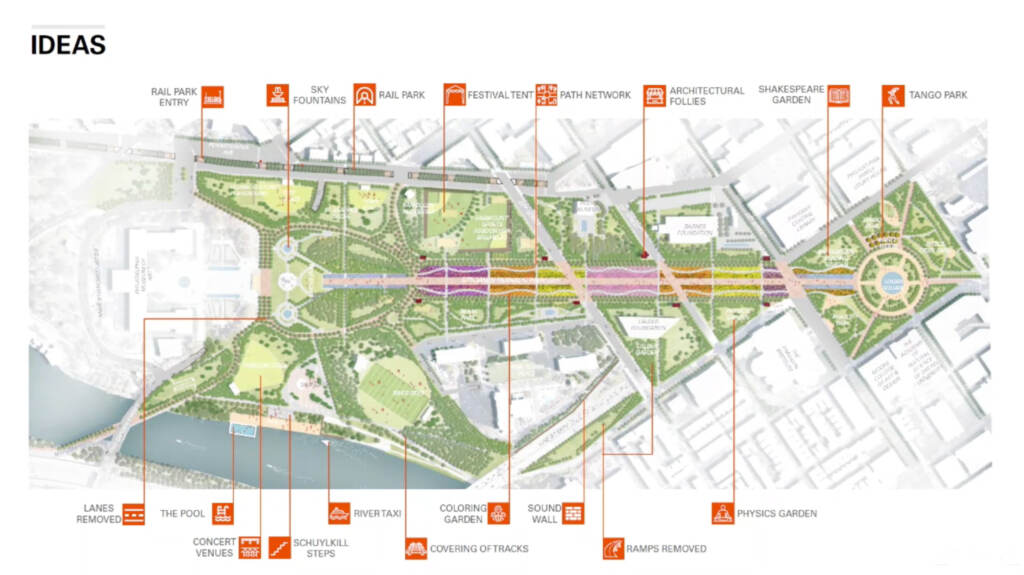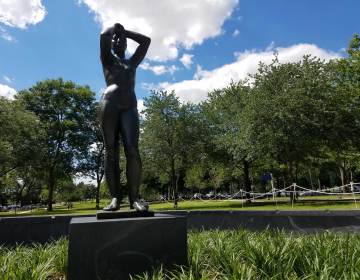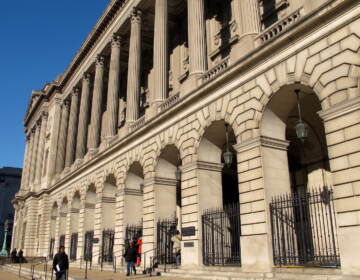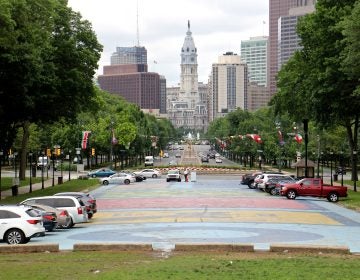‘Hot mess of cars’ to ‘holistic’: Designers offer a kinder Ben Franklin Parkway
The winning concepts focused on permanent pedestrian improvements for the infamously auto-centric parkway. A panel will eventually select a single plan.

An artist's rendering shows the Benjamin Franklin Parkway as reimagined by the Philadelphia firm DIGSAU and DLANDstudio of New York. (DIGSAU and DLANDstudio)
Three design firms are pitching visions for a more walkable, accessible, and inclusive Benjamin Franklin Parkway.
The proposals — unveiled during a city-sponsored Parkway Ideas Workshop charette held Wednesday — mark the culmination of a more than decade-old “More Park, Less Way” initiative.
Eventually, one will be selected to guide redesign efforts to remake the triumphalist boulevard long criticized as too auto-centric.
“This is about a vision and a framework,” said Harris Steinberg, executive director of Drexel University’s Lindy Institute for Urban Innovation, which worked with the city’s Department of Parks & Recreation and the Office of Transportation, Infrastructure, and Sustainability on the request for proposal process. “It is intended to stimulate a sustained public discussion.”
Each proposal offered a different focus, but they shared a goal of making the space more pedestrian-friendly and diverse. Steinberg said the goal was to create a “cosmopolitan canopy” — an allusion to Yale sociologist Elijah Anderson’s concept of truly welcoming, multi-ethnic public spaces.
“We want a people-centric park that also handles traffic, events, history, and modernity,” he said.
Each team also focused heavily on permanent pedestrian improvements — with all three plans called for traffic lane closures and the removal of cars from Logan Circle.
The Design Workshop, based in North Carolina, pitched their concept as reversing successive years of auto-centered redevelopment, like the installation of highway ramps. Their 10-year plan proposes “disconnecting the Parkway from nearby interstates.” It includes a cap over I-676, removal of nearby onramps, and total pedestrianization of the Parkway itself. Existing surface traffic would be routed onto nearby Pennsylvania Avenue, behind the city’s famed Art Museum, the widening of an existing tunnel under Eakins Oval, and a proposed extension of Martin Luther King Boulevard to Market Street.

“All around the world people are rejecting the idea of cars as a given,” said CEO Kurt Culbertson “We want to transform the Parkway from a major roadway back to Philadelphia’s garden.”
The boulevard’s central lanes would be converted into a pedestrianized area that would feature art installations and Logan Circle would be converted from a roundabout back into a public square. The plan also emphasizes more connectivity with the nearby Schuylkill riverfront and a disused rail tunnel some have eyed for use as a subterranean park.
While more radical changes the plan would come down the road, it also calls for immediate “tactical urbanism” — steps like installing traffic calming at the famed Art Museum steps and closing speed lanes around Eakins Oval.
From parking lot to boulevard
The Brooklyn-based design firm DLANDstudio and Center City-based partner DIGSAU, meanwhile offered a plan that took a more “holistic view” of the various “systems” that made up the Parkway from the built infrastructure to geomorphology and the hydrology of the terrain.
This plan focused on “healing the landscape” — rehabbing the natural environment, removing more paving, planting ecologically diverse plants, and restoring water features to parkland areas.
“Our proposal is about healing the landscape and restoring native ecologies,” DIGSAU principal Jamie Unkefer said.
It also, of course, addresses what the team dubbed the “hot mess of the car” — calling for series of smaller roundabouts around the Art Museum to maintain traffic connections, while converting nearby ancillary roadways that today largely serve as linear parking lots, like Pennsylvania Ave, into “dignified” boulevards in their own right. Renderings showed a more radical redesign of the Parkway itself, converting Eakins oval into a wooded area and creating a much wider and more direct pedestrian promenade from the Art Museum steps all the way to City Hall.
The plan also called for more modular event infrastructure and amenities throughout the Parkway.
Going Dutch and green
MVRDV, a Netherlands-based design firm, took a different approach, offering a trio of more conceptual ideas which, in true Dutch democratic fashion, the public could choose from. All broadly called for stripping out traffic from at least the central Parkway lanes and Logan Circle.
The first, “The Green Machine,” would focus on improving and expanding park space, closing both the central lanes of the Parkway, Logan Circle, and a portion of 21st Street to car traffic. It also calls for “a ring road,” with outer lanes converted to rapid bus service. Other traffic would be routed through a new tunnel beneath 22nd Street and an existing trolley tunnel underneath Eakins Oval, which would be expanded to accommodate westbound traffic.
Another concept, called “the Active Grid,” would reintroduce elements of the city’s street grid which were largely erased during the construction of the Parkway that could be flexibly programmed or developed. Another, “The Urban Theater,” would convert the center of the Parkway into a programmable lawn ringed by possible development or other amenities.
Unlocking the ‘fortress in the garden’
Three guest panelists generally reacted favorably to all the proposals, but also highlighted other concerns.
Tya Winn, executive Philadelphia Community Design Collaborative, said one priority should be unlocking the “fortress in the garden” — improving connections to sometimes inaccessible-seeming cultural institutions along the Parkway. She also said that while the focus on pedestrian improvements was laudable, any plan also needed to take into account how people would access the Parkway in the absence of automobiles.
“I agree with the phaseout of the car, but it’s also about how people are getting there,” she said. “Today, many Philadelphians still get down here by their car.”
University of Pennsylvania professor David Brownlee, noted the public and political obstacles to actually executing plans to pedestrianize the Parkway, and that pathways to practical implementation were just as important.
“Getting cars off the Parkway isn’t exactly a new idea,” he said.
The city recently saw the popular closure of MLK Drive to auto traffic during the pandemic reversed due to complaints from drivers, and replaced with an underwhelming bike lane that elicited jeers from bicycle advocates.
But Mitchell Silver, outgoing Commissioner of the New York City’s Department of Parks and Recreation, praised bold initiatives for restoring pedestrian access.
“We closed off Times Square, the crossroads of the world, to cars,” he said. “The cars adjusted. It can work.”
The city will post a survey on www.phlparkway.com in the coming days to gauge public reaction ahead of a vote to select a final design team later this summer.

Subscribe to PlanPhilly
WHYY is your source for fact-based, in-depth journalism and information. As a nonprofit organization, we rely on financial support from readers like you. Please give today.








